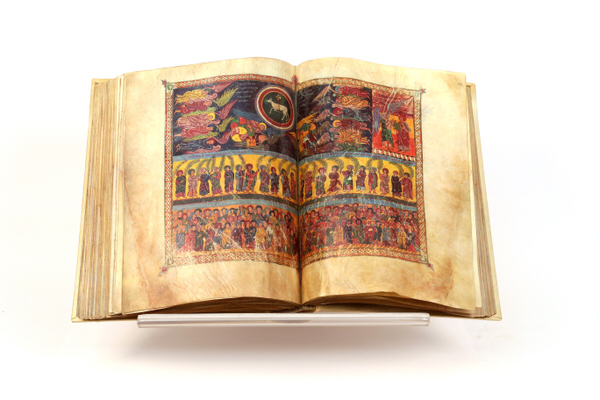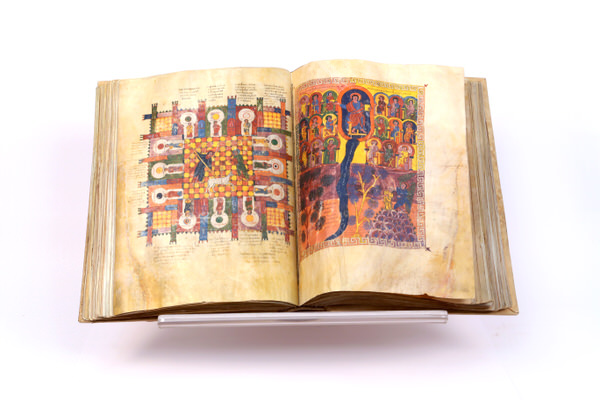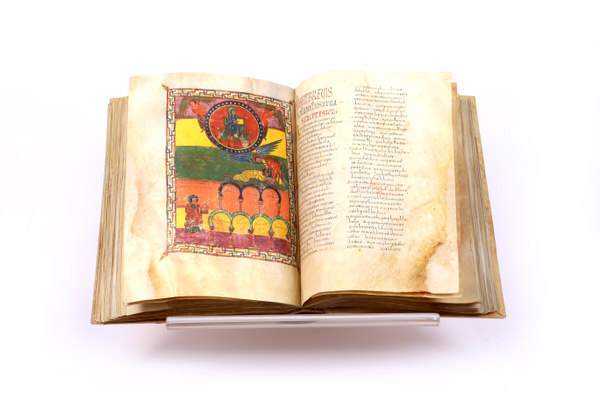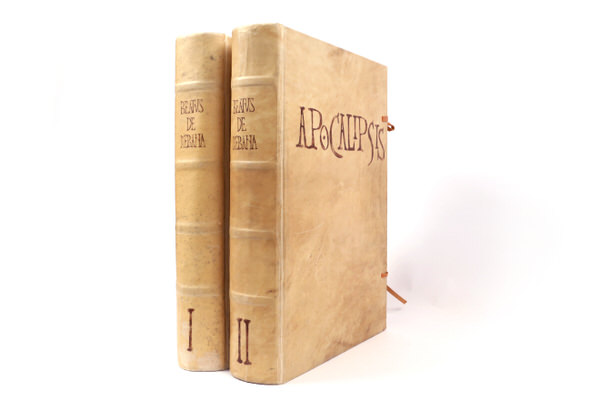With such a purchase, the Morgan Library is now in possession of one of the most spectacularly illuminated texts dating from the high Middle Ages. In fact, no biblical commentary has ever been so extravagantly illuminated.
Saint John’s Apocalypse. Beatus of Liébana.
San Miguel de Escalada.
10TH CENTURY
Original currently at the Pierpont Morgan Library . New York.
EDITION SOLD OUT
The story of the Beato Saint Michael of Escalada began in the middle of the X century, when a monk called MAIUS. was commissioned from the abbot at the Monastery of Saint Michael in León, with a copy of the commentary of Beato. Today, this copy is the oldest testimony to a change in the tradition of manuscripts on the Apocalypse in Spain. It is a pictorial reformation for which ? if we are not taken in by the accidental nature of the copies that have survived from such a distant period of history , MAIUS was responsible.
On his death in 1566, the archbishop of Valencia, Martín Perez de Ayala, left the manuscript to the military order of Saint James at the grand master's residence in Uclés, near Cuenca. It remained there until 1837, when the possessions and land of the church in Spain were sold. Around 1840, a merchant called Roberto Frasineli handed over the manuscript in exchange for an old silver watch. Later, in 1847, Francique Michel sold it for 1,040 francs.
The unscrupulous manuscript collector Guillermo Libri, bought the manuscript a little later for 1,500 francs, and before 1852 he sold it for 12,500 francs to the Count of Ashburnham. In May 1897, the collector Hanry Yates Thompson (from London) bought the manuscript on 3 June 1919 as lot 21, through the intermediary Quartich, for the Pierpont Morgan Library in New York.
With such a purchase, the Morgan Library is now in possession of one of the most spectacularly illuminated texts dating from the high Middle Ages. In fact, no biblical commentary has ever been so extravagantly illuminated.
Technical Information
The edition consists of two volumess of the original manuscript, which can be found at the Pierpont Morgan Library in New York. With measures approximately 40 x 30 cm and each volume has around 300 pages.
In addition there is a study volume containing:
- The old history of the Magio manuscript
- Modern history...
- A codicological study
- A study of the illumination
- An introduction to the text
- A transcription - translation into Spanish and English.
William M. Voelkle, lecturer in Medieval and Renaissance Studies at the University of New York, and head of the section of Medieval and Renaissance Manuscripts at the Pierpont Morgan Library, is also the owner of the oldest Beato codex (the M644 Morgan Manuscript) and the most modern, richest and longest manuscript of the Strikes (the M489 Beato codex). From amongst his work we can point out "Jewels of the Paul Getty Collection", "Treasures in Illuminated Manuscripts at the Pierpont Morgan Library".
John W. Williams, lecturer in Fine Arts at the University of Pittsburg. His following works stand out: "The illustrated Beatos (codex), Corpus of illustrations on the Commentary of the Apocalypse", J. Paul Getty Foundation, Millar Meiss Foundation.
Barbara A. Shailor, lecturer in Classical Philology at the University of Cincinnati, and a member of the American Association of Philology and the Medieval Academy of America. She is a specialist in Latin Palaeography and Codicology. Amongst her works stand out "The Medieval Book", "Medieval texts and studies of the Renaissance".
The lecturer Leslie G. Freeman, a specialist in Historical and Prehistorical Anthropology, is professor at the University of Chicago. He has published studies on the meaning of symbolism in Christian art during the high Middle Ages. At present, he is preparing the English version of the present work.
Alberto del Campo Hernández, lecturer at the University of Cantabria, studied theology at the Pontificate Gregorian University of Rome. In 1991, he published a bilingual edition of the "Commentary on the Apocalypse", by Apringio de Beja, which was widely used by Beato of Liébana in his own work.
Dr. Joaquín González Echegaray is a prestigious archaeologist who has lead excavation work in Spain and the Near East, and has published numerous books and articles on this speciality. He is an expert on Ancient and Medieval History of settlements in the north of the peninsula, and is the author of the well-known work "Los cántabros" ("The Cantabrians") (Madrid 1966).






